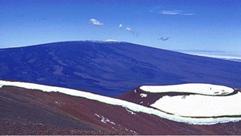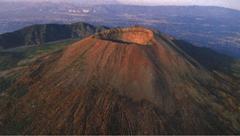Viscosity and Gas Content - a Coca-cola eruption
Predicting the likely type of eruption from a volcano is as important in saving lives as predicting when it will erupt. The chief factors affecting the style of eruption are the viscosity of the magma (dependent on composition and the time that it has been cooling within the crust) and the amount of dissolved gases that it contains (water, CO2 etc.). See the images below for two vocanoes which erupted with differing visocity magma.
The short video clip shows the effect of opening a bottle of cola that has been “doctored” with wallpaper paste to make it more viscous, as compared to “normal” cola (slightly de-gassed beforehand). The demonstration (see “Experiments & Demonstrations”) illustrates how viscous, gas-rich magmas erupt to form pumice and pyroclastics (ash and bombs).
A useful starter is to get pupils to blow bubbles in water and in treacle using a straw. A significant lung pressure is needed for the treacle – even with a thin straw - the significance of this (high pressures needed for eruption) is worth discussing.
Whilst gas escapes easily from the “normal” cola upon release of pressure (some frothing may occur briefly), the “pasty” cola froths into a mousse and more than half the contents of the bottle may be ejected as it does so. Note that, as the “eruption” ends, the remaining froth in the bottle collapses quite suddenly, mimicking the end of a volcanic “super-eruption” that results in ground collapse and the formation of a caldera.
It is useful to have a decent-sized chunk of pumice (obtainable from many Chemists’ shops) for students to pass around during the follow-up discussion.
The short video clip shows the effect of opening a bottle of cola that has been “doctored” with wallpaper paste to make it more viscous, as compared to “normal” cola (slightly de-gassed beforehand). The demonstration (see “Experiments & Demonstrations”) illustrates how viscous, gas-rich magmas erupt to form pumice and pyroclastics (ash and bombs).
A useful starter is to get pupils to blow bubbles in water and in treacle using a straw. A significant lung pressure is needed for the treacle – even with a thin straw - the significance of this (high pressures needed for eruption) is worth discussing.
Whilst gas escapes easily from the “normal” cola upon release of pressure (some frothing may occur briefly), the “pasty” cola froths into a mousse and more than half the contents of the bottle may be ejected as it does so. Note that, as the “eruption” ends, the remaining froth in the bottle collapses quite suddenly, mimicking the end of a volcanic “super-eruption” that results in ground collapse and the formation of a caldera.
It is useful to have a decent-sized chunk of pumice (obtainable from many Chemists’ shops) for students to pass around during the follow-up discussion.
Hawaii – shield volcano
 Hawaii – shield volcano with shallow slopes, formed from runny basalt magma.
Hawaii – shield volcano with shallow slopes, formed from runny basalt magma.Vesuvius – composite cone volcano
 Vesuvius – composite cone volcano with steep slopes, apt to erupt explosively.
Vesuvius – composite cone volcano with steep slopes, apt to erupt explosively.
